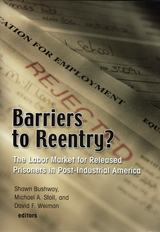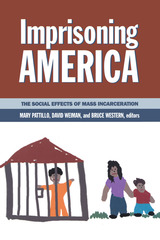2 books by Weiman, David

Barriers to Reentry?
The Labor Market for Released Prisoners in Post-Industrial America
Shawn D. Bushway
Russell Sage Foundation, 2007
With the introduction of more aggressive policing, prosecution, and sentencing since the late 1970s, the number of Americans in prison has increased dramatically. While many have credited these "get tough" policies with lowering violent crime rates, we are only just beginning to understand the broader costs of mass incarceration. In Barriers to Reentry? experts on labor markets and the criminal justice system investigate how imprisonment affects ex-offenders' employment prospects, and how the challenge of finding work after prison affects the likelihood that they will break the law again and return to prison. The authors examine the intersection of imprisonment and employment from many vantage points, including employer surveys, interviews with former prisoners, and state data on prison employment programs and post-incarceration employment rates. Ex-prisoners face many obstacles to re-entering the job market—from employers' fears of negligent hiring lawsuits to the lost opportunities for acquiring work experience while incarcerated. In a study of former prisoners, Becky Pettit and Christopher Lyons find that employment among this group was actually higher immediately after their release than before they were incarcerated, but that over time their employment rate dropped to their pre-imprisonment levels. Exploring the demand side of the equation, Harry Holzer, Steven Raphael, and Michael Stoll report on their survey of employers in Los Angeles about the hiring of former criminals, in which they find strong evidence of pervasive hiring discrimination against ex-prisoners. Devah Pager finds similar evidence of employer discrimination in an experiment in which Milwaukee employers were presented with applications for otherwise comparable jobseekers, some of whom had criminal records and some of whom did not. Such findings are particularly troubling in light of research by Steven Raphael and David Weiman which shows that ex-criminals are more likely to violate parole if they are unemployed. In a concluding chapter, Bruce Western warns that prison is becoming the norm for too many inner-city minority males; by preventing access to the labor market, mass incarceration is exacerbating inequality. Western argues that, ultimately, the most successful policies are those that keep young men out of prison in the first place. Promoting social justice and reducing recidivism both demand greater efforts to reintegrate former prisoners into the workforce. Barriers to Reentry? cogently underscores one of the major social costs of incarceration, and builds a compelling case for rethinking the way our country rehabilitates criminals.
[more]

Imprisoning America
The Social Effects of Mass Incarceration
Mary Pattillo
Russell Sage Foundation, 2004
Over the last thirty years, the U.S. penal population increased from around 300,000 to more than two million, with more than half a million prisoners returning to their home communities each year. What are the social costs to the communities from which this vast incarcerated population comes? And what happens to these communities when former prisoners return as free men and women in need of social and economic support? In Imprisoning America, an interdisciplinary group of leading researchers in economics, criminal justice, psychology, sociology, and social work goes beyond a narrow focus on crime to examine the connections between incarceration and family formation, labor markets, political participation, and community well-being. The book opens with a consideration of the impact of incarceration on families. Using a national survey of young parents, Bruce Western and colleagues show the enduring corrosive effects of incarceration on marriage and cohabitation, even after a prison sentence has been served. Kathryn Edin, Timothy Nelson, and Rechelle Parnal use in-depth life histories of low-income men in Philadelphia and Charleston, to study how incarceration not only damages but sometimes strengthens relations between fathers and their children. Imprisoning America then turns to how mass incarceration affects local communities and society at large. Christopher Uggen and Jeff Manza use survey data and interviews with thirty former felons to explore the political ramifications of disenfranchising inmates and former felons. Harry Holzer, Stephen Raphael, and Michael Stoll examine how poor labor market opportunities for former prisoners are shaped by employers' (sometimes unreliable) background checks. Jeremy Travis concludes that corrections policy must extend beyond incarceration to help former prisoners reconnect with their families, communities, and the labor market. He recommends greater collaboration between prison officials and officials in child and family welfare services, educational and job training programs, and mental and public health agencies. Imprisoning America vividly illustrates that the experience of incarceration itself—and not just the criminal involvement of inmates—negatively affects diverse aspects of social membership. By contributing to the social exclusion of an already marginalized population, mass incarceration may actually increase crime rates, and threaten the public safety it was designed to secure. A rigorous portrayal of the pitfalls of getting tough on crime, Imprisoning America highlights the pressing need for new policies to support ex-prisoners and the families and communities to which they return.
[more]
READERS
Browse our collection.
PUBLISHERS
See BiblioVault's publisher services.
STUDENT SERVICES
Files for college accessibility offices.
UChicago Accessibility Resources
home | accessibility | search | about | contact us
BiblioVault ® 2001 - 2024
The University of Chicago Press









